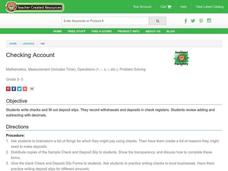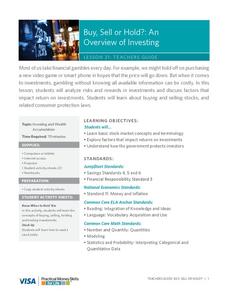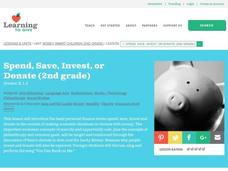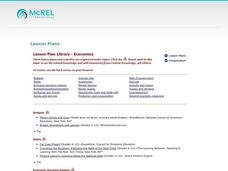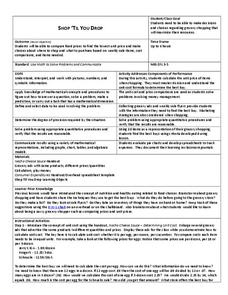Curated OER
Financial Literacy - Consumer Credit
Young scholars explore consumer credit and how it works.
Curated OER
Financial Literacy - Consumer Credit
Learners investigate consumer credit and how it works. They also examine basic types of credit, risks and responsibilities associated with credit, ways to establish and maintain good credit, ways to avoid hurting ones credit and what one...
Curated OER
Financial Literacy - Consumer Privacy
Students investigate consumer privacy and how it works. They also describe the rights and responsibilities of buyers and sellers under consumer protection laws and complete a list of activities and assignments on consumer privacy.
PricewaterhouseCoopers
Buying a Home: Mortgage Decisions
High schoolers don't think they need to know about mortgages, but with college and renting soon approaching, fiscal responsibility is necessary. Pupils learn the vocabulary of a mortgage and calculate different home values to determine...
Curated OER
Checking Account
Students keep track of finances in a check register. In this checking account lesson, students practice writing checks and deposit slips as they add and subtract decimal amounts in order to balance a checkbook in a register.
Curated OER
Making a Spreadsheet
Students explore spreadsheet software. In this personal finance and computer technology lesson, students develop a vacation spreadsheet on the computer. Students represent hotel, food, transportation, and entertainment costs on a graph...
Visa
Dream Big: Money and Goals
Whether their objective is independent living, going to college, or buying a car, pupils will participate in discussions and complete worksheets to gain an understanding of how short- and long-term goals play a large role in helping...
Visa
Buy, Sell or Hold?: An Overview of Investing
Break down the often-daunting topic of the stock market with this resource, in which pupils learn basic terminology regarding buying and selling stocks, as well as the factors that influence how much return individuals can receive on...
Curated OER
Invest In Yourself
Students learn about budgeting, saving, dept, financial management, opportunity cost, and self-regulation. For this financial management lesson, students apply their knowledge of finance components and create their own web based plan...
Curated OER
Mr. Popper's Penguin's
Fourth graders locate Antarctica and recognize it as the setting of Mr. Popper's Penguins. In this Mr. Popper's Penguins lesson plan, 4th graders understand the financial decisions made by Mr. Popper. Students discuss wise spending....
Curated OER
The Hundred Penny Box
Students compare how people save money in financial institutions, after reading the story, The Hundred Penny Box. They analyze the advantages of regular saving and how savings grow with compounding.
Curated OER
Money Smart children
Students elementary financial vocabulary words: spend, save, invest and donate. In this finance lesson plan, students respond to the story "Sam and the Lucky Moon." Students describe the concepts of wants and needs, resources, scarcity,...
Curated OER
Bedroom Redecoration Project
In this bedroom redecoration project, your young mathematicians become interior designers. They plan, draw, and determine finances for the project. They apply their knowledge of working with decimals, geometric shapes, and problem...
Curated OER
Micro Economics - Personal Budgeting
Students explore the real world as it relates to money and how people use it. In this money management lesson, students jump into the real world as they role play with money through spending, saving, being married, single, having...
Curated OER
Shop 'Til You Drop
Students evaluate food prices. In this real world math lesson plan, students compare the cost of various grocery items to determine which is the best deal. They work in groups using grocery ads to decide how to get the most product for...
Curated OER
Labor, Choice, and Sales Tax
Students consider the idea of earning and spending money. For this money management lesson plan, students discuss the concept of saving and spending money through the reading of a story and by completing several activities that involve...
Curated OER
Bright Ideas for Bringing up Smart Savers
Students explore the concept of saving money. In this saving money lesson, students read an article about saving money. Students discuss ways to save money and what makes it difficult to save money. Students compare prices of products.
Curated OER
Money Math
Students explore a story about a room decoration activity to learn about measurements and area. In this measurement lesson, students listen to a story about a boy who is redecorating his bedroom. Students discuss the story and work in...
Curated OER
Keeping Track of Our Money
Second graders complete activities to learn how to manage money. In this managing money lesson plan, 2nd graders read the book How the Second Grade Got $8,205.50 to Visit the Statue of Liberty and complete two related worksheets.
Curated OER
Lesson 2: Savings Accounts and U.S. Savings Bonds
Students explore the importance of savings accounts and U.S. Savings Bonds. They study the concept of simple interest through a math activity.
Practical Money Skills
Making Decisions
A set of quizzes and assessments would make a great companion to your lesson on making decisions and opportunity risks. Learners watch a PowerPoint before answering multiple choice questions about interest rates, saving money, and the...
Insurance Zebra
Insurance Curriculum for Middle and High School Teachers
Liability, deductible, premium ... what do these words mean, and how do they relate to insurance? Scholars complete a pre-test, matching vocabulary activity, and insurance timeline worksheet and become familiar with these terms. Next,...
Curated OER
There's No Accountin with Ledgers
Tenth graders create and maintain a ledger, write an essay for the process, and learn to keep financial accounts through the ledger. For this ledger lesson, 10th graders define an accounting ledger and create one for the money they've...
Curated OER
Reno's Dilemma
Students explain proportions as it relates to principle and interest. They use proportions to explain relationships and analyze relationships by identifying patterns.






